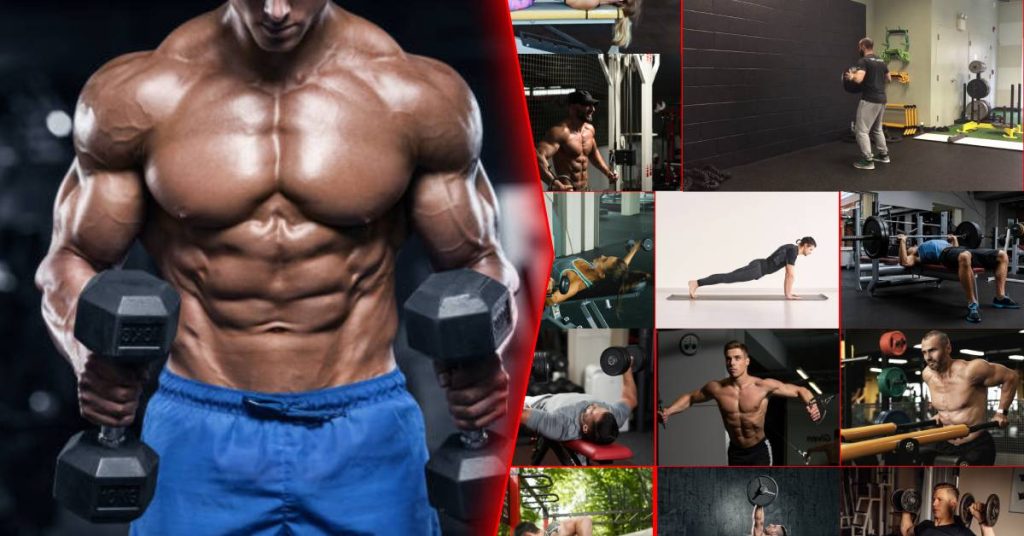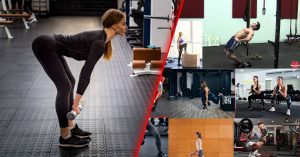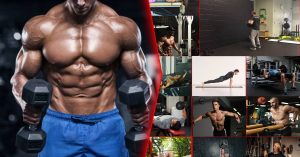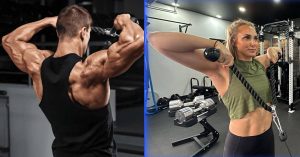You may be searching over the internet what are the Top Compound Chest Exercises to improve your strength in the upper body and overall fitness. If that’s the case, you don’t need to look further elsewhere. It’s because we have covered all your best exercise options that can help you achieve your goal with this article.
Let’s get started…
Table of contents
MORE keyboard_double_arrow_down LESS keyboard_double_arrow_up
What is meant by Compound Chest Exercises?
Compound Chest Exercises refer to exercises that target the chest muscles (pectoral muscles) while also engaging multiple other muscle groups simultaneously. These exercises involve movements across multiple joints and typically recruit muscles not only in the chest but also in the shoulders, triceps, and even the core to stabilize the body.
These exercises are often considered more efficient and effective for building overall upper body strength and muscle mass compared to isolation exercises, which target only a single muscle group. They often mimic natural, functional movements and can help improve coordination and stability.
Why Compound Chest Exercises Matter?
Compound Chest Exercises are essential parts of strength training and muscle development in fitness. They play a significant role in sculpting and strengthening the upper body. Unlike isolated exercises, compound chest workouts target multiple muscle groups simultaneously. It leads to a comprehensive transformation beyond chest enhancement alone.
By engaging various muscles in the upper body, these workouts not only promote strength but also enhance overall functionality.
Therefore, understanding their mechanics and advantages will reveal their potential to revolutionize your fitness regimen. Imagine not only increasing strength but also achieving better balance and functional fitness. The key to such transformations lies in understanding the effectiveness of compound movements.
After doing a number of research and practice trials, here is our list of the best compound chest workouts that are worth including in your daily exercise routine.
Top 13 Compound Chest Exercises:
Ready to elevate your chest workout routine? Dive into our carefully curated list of the top 13 compound chest exercises. From bench presses to cable crossovers, these dynamic moves will help you achieve a stronger, more defined chest.
Here are our top 13 suggestions…
1. Barbell Bench Press
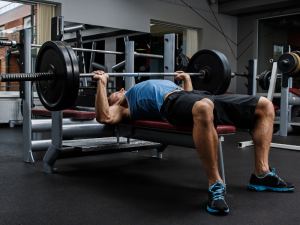
The bench press is a foundational compound exercise that targets the chest, shoulders, and triceps. It’s a staple in strength training routines and is performed using a barbell on a flat bench.
How To Do Barbell Bench Press?
- Lie flat on a bench with your feet planted firmly on the ground.
- Grip the barbell slightly wider than shoulder-width apart, ensuring your wrists are straight.
- Lower the barbell to your chest under control, keeping your elbows at a 45-degree angle.
- Press the barbell back up to the starting position, fully extending your arms.
Execution Tips Enhanced:
- Maintain a slight arch in your lower back and keep your shoulder blades retracted throughout the movement.
- Engage your core muscles to stabilize your body.
- Lower the barbell in a controlled manner to maximize muscle engagement and minimize the risk of injury.
Why It Works Explained:
The bench press effectively targets the chest muscles, particularly the pectoralis major, while also engaging the shoulders and triceps. By lifting heavy weights in a compound movement pattern, it promotes strength and muscle growth in the upper body.
2. Push-Ups
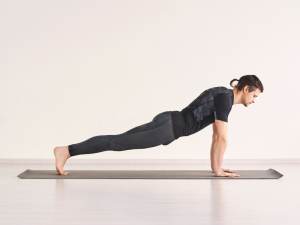
Push-ups are a versatile bodyweight exercise that targets the chest, shoulders, triceps, and core muscles. They can be modified to suit different fitness levels and goals, making them accessible to beginners and challenging for advanced exercisers.
How To Do Push-Ups?
- Start in a plank position with your hands slightly wider than shoulder-width apart.
- Lower your body towards the ground by bending your elbows, keeping them close to your body.
- Push through your palms to straighten your arms and return to the starting position.
Execution Tips Enhanced:
- Maintain a straight line from your head to your heels throughout the movement.
- Keep your core muscles engaged to prevent your hips from sagging or lifting too high.
- Focus on controlled movement and full range of motion to maximize muscle engagement.
Why It Works Explained:
Push-ups effectively target the chest muscles, as well as the shoulders and triceps, while also engaging the core for stability. They provide a challenging bodyweight exercise that can help build strength, endurance, and muscle definition in the upper body.
3. Dumbbell Press
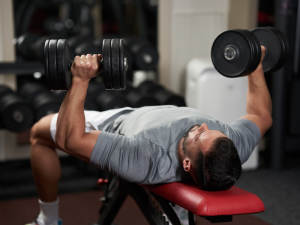
Dumbbell presses are versatile compound exercises that target the chest, shoulders, and triceps while also engaging stabilizer muscles for balance and control. They offer a greater range of motion compared to the barbell bench press and can help address muscle imbalances.
How To Do Dumbbell Presses?
- Sit on a bench with back support, holding a dumbbell in each hand at shoulder level.
- Press the dumbbells upwards until your arms are fully extended, keeping your wrists straight.
- Lower the dumbbells back down to shoulder level under control.
Execution Tips Enhanced:
- Keep your elbows slightly bent throughout the movement to avoid locking them out at the top.
- Engage your core muscles and maintain a stable base by pressing your feet firmly into the ground.
- Focus on a slow and controlled movement pattern to maximize muscle engagement and reduce the risk of injury.
Why It Works Explained:
Dumbbell presses target the chest muscles, particularly the pectoralis major, while also engaging the shoulders and triceps. The use of dumbbells allows for a greater range of motion and helps improve muscle balance and coordination by requiring each arm to work independently.
4. Dips
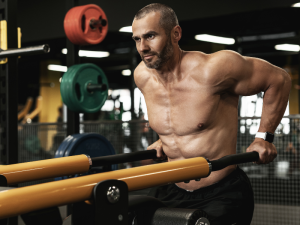
Dips are compound exercises that primarily target the chest, shoulders, and triceps while also engaging the muscles of the upper back and core for stabilization. They can be performed using parallel bars or a bench, making them accessible in various gym settings. There are two kinds of dip exercises that people love to try out often.
- Dips: Dips primarily target the chest, shoulders, and triceps, as well as the muscles of the upper back and core for stabilization.
- Chest Dips: Chest dips are a variation of dips that place more emphasis on the chest muscles compared to tricep dips.
How To Do Dips?
- Grip the parallel bars with your palms facing inward and your arms fully extended.
- Lower your body by bending your elbows until your upper arms are parallel to the ground.
- Push through your palms to straighten your arms and return to the starting position.
Execution Tips Enhanced:
- Keep your chest lifted and your shoulders pulled back throughout the movement to maintain proper form.
- Avoid swinging or using momentum to lift your body, focusing on controlled movement.
- Engage your core muscles to stabilize your body and prevent excessive arching of the lower back.
Why It Works Explained:
Dips effectively target the chest, shoulders, and triceps, providing a challenging bodyweight exercise that helps build upper body strength and muscle definition. They also engage the muscles of the upper back and core, contributing to overall stability and functional fitness.
5. Chest Dips
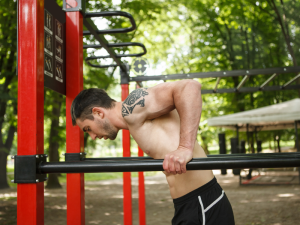
Chest dips are a variation of dips that specifically target the chest muscles, placing more emphasis on chest activation compared to tricep dips. These exercises are performed using parallel bars and are effective for building upper body strength and muscle definition.
How To Do Chest Dips?
- Begin by standing between a set of parallel bars, gripping each bar firmly with your palms facing inward (towards your body) and your arms fully extended.
- Lift yourself up so your arms are supporting your body weight, keeping your torso upright, shoulders back, and chest lifted.
- Lower your body by bending your elbows, allowing them to flare out to the sides, until your upper arms are approximately parallel to the ground or until you feel a comfortable stretch in your chest.
- Push through your palms to straighten your arms and return to the starting position, exhaling as you do so. Keep your chest lifted and your shoulders back throughout the movement.
- Complete the desired number of repetitions, maintaining controlled movement and focusing on engaging your chest, shoulders, and triceps throughout the exercise.
Execution Tips Enhanced:
- Maintain a smooth and controlled movement throughout the exercise, avoiding any sudden jerking motions.
- Keep your elbows slightly flared out to the sides to target the chest muscles more effectively.
- Focus on maintaining tension in your chest muscles throughout the entire range of motion.
- Engage your core muscles to stabilize your body and prevent excessive swinging or arching of the lower back.
- If you’re new to chest dips or find them challenging, you can use assistance from a resistance band looped around the bars or ask a spotter to assist you by supporting your legs.
Why It Works Explained:
Chest dips effectively target the chest, shoulders, and triceps, providing a challenging bodyweight exercise that helps build upper body strength and muscle definition. They also engage the muscles of the upper back and core, contributing to overall stability and functional fitness.
6. Chest Dumbbell Flyes
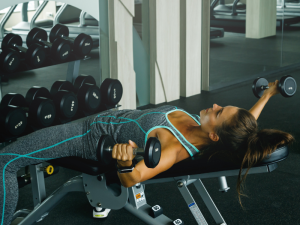
Chest dumbbell flyes are isolation exercises that primarily target the chest muscles, particularly the pectoralis major. While they are not strictly compound movements, they can still be effective in building chest strength and definition when combined with compound exercises.
How To Do Chest Dumbbell Flyes?
- Lie flat on a bench with a dumbbell in each hand, palms facing inward.
- Extend your arms above your chest with a slight bend in your elbows.
- Lower the dumbbells out to the sides in a wide arc, keeping a slight bend in your elbows.
- Return to the starting position by squeezing your chest muscles.
Execution Tips Enhanced:
- Keep a slight bend in your elbows throughout the movement to avoid hyperextension.
- Focus on a slow and controlled movement pattern, emphasizing the stretch and contraction of the chest muscles.
- Avoid using excessive weight to prevent strain on the shoulder joints.
Why It Works Explained:
While chest dumbbell flyes primarily isolate the chest muscles, they can still be beneficial in conjunction with compound movements for overall chest development. They emphasize the stretch and contraction of the chest muscles, helping to improve muscle definition and symmetry.
7. Cable Chest Press
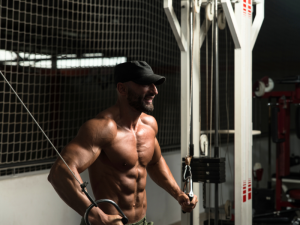
The cable chest press is a variation of the bench press using a cable machine, which provides constant tension throughout the movement. This exercise targets the chest muscles while also engaging the shoulders and triceps.
How To Do Cable Chest Press?
- Stand facing away from the cable machine with a handle in each hand at chest height.
- Step forward slightly and position your feet shoulder-width apart for stability.
- Press the handles forward until your arms are fully extended, keeping your elbows slightly bent.
- Slowly return to the starting position under control, maintaining tension in the chest muscles.
Execution Tips Enhanced:
- Keep your chest lifted and your shoulders relaxed throughout the movement to maintain proper form.
- Engage your core muscles to stabilize your body and prevent excessive arching of the lower back.
- Focus on a smooth and controlled movement pattern, avoiding jerky or rapid movements.
Why It Works Explained:
The cable chest press provides constant tension on the chest muscles throughout the movement, leading to greater muscle activation and development. It also helps improve stability and coordination by engaging the core muscles for balance.
8. Cable Crossover
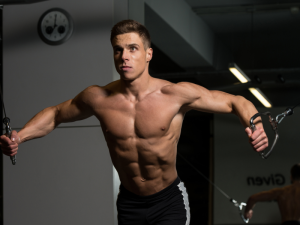
The cable crossover is a versatile exercise performed on a cable machine that effectively targets the chest muscles, particularly the inner chest. It allows for a wide range of motion and provides constant tension on the chest muscles throughout the movement.
How To Do Cable Crossover?
- Stand in the center of a cable machine with a handle attached to each side at shoulder height.
- Grasp the handles with an overhand grip and step forward slightly to create tension in the cables.
- Bring your hands together in front of your body, crossing them at chest level.
- Slowly return to the starting position, maintaining tension in the chest muscles.
Execution Tips Enhanced:
- Keep a slight bend in your elbows throughout the movement to avoid hyperextension.
- Focus on squeezing the chest muscles together at the peak of the movement to maximize muscle activation.
- Maintain a stable stance and engage your core muscles to prevent swaying or leaning during the exercise.
Why It Works Explained:
The cable crossover targets the chest muscles, particularly the inner chest, by providing constant tension throughout the movement. It helps improve muscle definition and symmetry while also enhancing stability and coordination in the upper body.
9. Incline Dumbbell Bench Press

The incline dumbbell bench press is a variation of the dumbbell press that targets the upper chest muscles more intensely. It involves lying on an incline bench with a dumbbell in each hand and pressing the weights upward.
How To Do Incline Dumbbell Bench Press?
- Set an incline bench at a 30-45 degree angle and sit down with a dumbbell in each hand.
- Lie back on the bench and press the dumbbells upward until your arms are fully extended, palms facing forward.
- Lower the dumbbells back down to shoulder level, keeping your elbows slightly bent.
- Press the dumbbells back up to the starting position, squeezing your chest muscles at the top of the movement.
Execution Tips Enhanced:
- Keep your shoulder blades retracted and your chest lifted throughout the movement to maintain proper form.
- Engage your core muscles to stabilize your body and prevent arching of the lower back.
- Focus on a controlled movement pattern, avoiding rapid or jerky movements.
Why It Works Explained:
The incline dumbbell bench press targets the upper chest muscles more intensely, helping to develop a well-rounded chest and improve overall upper body strength. It also engages the shoulders and triceps for a comprehensive upper body workout.
10. Standing Medicine Ball Chest Pass
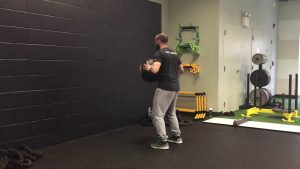
The medicine ball chest pass is a dynamic exercise that targets the chest, shoulders, and triceps while also incorporating power and coordination. It involves explosively pushing a medicine ball away from the chest, mimicking movements used in various sports and activities.
How To Do Medicine Ball Chest Pass?
- Stand facing a wall with your feet shoulder-width apart, holding a medicine ball at chest level.
- Explosively push the medicine ball away from your chest, extending your arms fully.
- Catch the ball as it rebounds off the wall and immediately repeat the movement.
Execution Tips Enhanced:
- Use a medicine ball that is appropriate for your strength and fitness level to ensure proper form and safety.
- Engage your core muscles to stabilize your body and maintain balance during the exercise.
- Focus on generating power from your chest and shoulders, using your triceps to extend your arms fully.
Why It Works Explained:
The medicine ball chest pass is an effective exercise for developing explosive power in the chest, shoulders, and triceps. It mimics movements used in sports such as basketball, volleyball, and boxing, making it a valuable addition to athletic training programs.
11. Dumbbell Shoulder Press
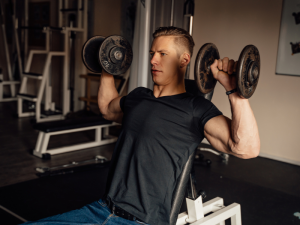
The dumbbell shoulder press is a compound exercise primarily targeting the deltoid muscles of the shoulders while also engaging the chest and triceps. It’s an effective way to build shoulder strength and size.
How To Do Dumbbell Shoulder Press?
- Sit on a bench with back support or stand with feet shoulder-width apart, holding a dumbbell in each hand at shoulder level.
- Press the dumbbells overhead until your arms are fully extended, palms facing forward.
- Lower the dumbbells back down to shoulder level with control, avoiding locking out your elbows.
- Repeat for the desired number of reps.
Execution Tips Enhanced:
- Keep your core engaged and avoid arching your lower back.
- Maintain a slight bend in your knees for stability.
- Focus on a controlled movement, especially during the lowering phase to maximize muscle engagement.
Why It Works Explained:
The dumbbell shoulder press targets the deltoid muscles, which are responsible for shoulder abduction and rotation. By pressing the dumbbells overhead, you engage these muscles along with the chest and triceps, promoting overall shoulder strength and stability.
12. Landmine Chest Presses
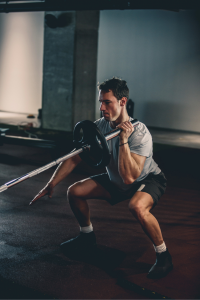
Landmine chest presses are a compound exercise that targets the chest muscles while also providing stability and control. Utilizing a landmine attachment, this exercise offers a unique and effective way to work the chest.
How To Do Landmine Chest Presses?
- Stand in front of the landmine attachment with feet shoulder-width apart, grasping the barbell with one hand at chest level.
- Press the barbell away from your chest, extending your arm fully.
- Slowly return the barbell back to your chest with control.
- Repeat on the other side or alternate sides for each set.
Execution Tips Enhanced:
- Keep your chest lifted and shoulders back throughout the movement.
- Engage your core muscles for stability and balance.
- Control the descent of the barbell to maximize time under tension.
Why It Works Explained:
Landmine chest presses target the chest muscles, particularly the pectoralis major, while also engaging the shoulders and triceps for stability. The angled movement pattern provides a unique challenge to the chest muscles, helping to improve muscle activation and strength.
13. Dumbbell Pullover
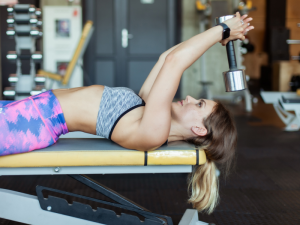
The dumbbell pullover is a compound exercise that targets the chest, back, and triceps. It’s performed lying on a bench, lowering a dumbbell behind your head, and then pulling it back over your chest.
How To Do Dumbbell Pullover?
- Lie flat on a bench with only your upper back and shoulders supported, holding a dumbbell with both hands above your chest.
- Lower the dumbbell behind your head in a controlled motion, keeping a slight bend in your elbows.
- Pull the dumbbell back over your chest using your chest and back muscles, extending your arms fully.
- Repeat for the desired number of reps.
Execution Tips Enhanced:
- Keep your core engaged and your lower back pressed into the bench throughout the movement.
- Focus on a smooth and controlled motion, avoiding any jerking or swinging of the weight.
- Use a weight that allows you to maintain proper form and complete the movement with control.
Why It Works Explained:
The dumbbell pullover targets the chest muscles, particularly the pectoralis major, while also engaging the muscles of the back and triceps. It’s an effective way to stretch and strengthen the chest muscles while also improving shoulder mobility and stability.
By following these guidelines and incorporating these top compound chest workouts into your routine, you can effectively target the chest muscles while also engaging other muscle groups for a balanced and effective upper body workout.
What are the benefits of including Compound movements in your daily workout?
Compound exercises act as the Swiss Army knife of the workout world, versatile and efficient. They’re like a magic formula that includes multiple muscle groups and joints with each movement.
Here’s how they make a difference:
- Efficiency: Compound movements target multiple muscle groups at once, allowing you to work more muscles in less time compared to isolated exercises. This efficiency is particularly useful if you have limited time for your workouts.
- Strength Gain: Compound movements typically involve heavier weights or resistance, which helps to build strength more effectively than isolated exercises. By recruiting multiple muscle groups, compound movements enable you to lift heavier loads, leading to greater strength gains over time.
- Muscle Mass: Since compound movements engage multiple muscles simultaneously, they stimulate more muscle fibers, leading to increased muscle growth or hypertrophy. This is especially beneficial for individuals looking to build muscle mass.
- Functional Fitness: Compound movements mimic natural, everyday movements, making them highly functional. By improving strength and coordination across multiple joints, compound exercises help enhance your ability to perform daily activities and sports-related tasks.
- Calorie Burn: Compound movements require more energy expenditure due to the involvement of multiple muscle groups. This can contribute to a higher calorie burn during and after your workout, which may be beneficial for weight loss or weight management goals.
- Hormonal Response: Compound movements have been shown to elicit a greater hormonal response, including the release of testosterone and growth hormone, which are important for muscle growth and recovery.
- Core Stability: Many compound movements require core stabilization to maintain proper form and balance. By strengthening the core muscles, compound exercises can improve overall stability and reduce the risk of injury.
- Progressive Overload: Compound movements lend themselves well to progressive overload, which is essential for continuous improvements in strength and muscle mass. You can gradually increase the weight or resistance over time, challenging your muscles to adapt and grow stronger.
Essential Takeaways
In conclusion, integrating compound chest exercises into your workout regimen can yield remarkable benefits, including increased strength, muscle growth, and overall physical fitness.
Consistency and proper form are key to maximizing the effectiveness of these exercises while minimizing the risk of injury. Focus on maintaining good posture throughout each repetition to ensure optimal muscle engagement and development.
Pairing compound chest exercises with complementary lower-body and upper-body workouts can further enhance your overall strength and muscular development.
Don’t hesitate to include some of these top compound chest exercises into your daily routine today. With dedication and persistence, you can achieve an impressive chest and elevate your fitness journey to new heights.
Key Points
- Compound chest workouts involve exercises targeting the chest muscles while engaging multiple other muscle groups simultaneously, leading to efficient muscle building and strength enhancement.
- These workouts are more efficient and effective compared to isolation exercises as they work multiple muscle groups in a single movement, making them ideal for building overall upper body strength and muscle mass.
- Compound chest workouts are essential for strength training and muscle development, playing a significant role in sculpting and strengthening the upper body beyond chest enhancement alone.
- By engaging various muscles in the upper body, compound chest workouts promote not only strength but also enhance overall functionality, helping individuals perform daily activities and sports-related tasks more efficiently.
- Understanding the mechanics and advantages of compound movements reveals their potential to revolutionize fitness regimens, offering benefits such as improved balance, coordination, and functional fitness.
- Incorporating compound chest exercises into daily workout routines can lead to significant improvements in strength, muscle definition, and overall physical fitness.
- The top compound chest exercises mentioned provide a diverse range of options, from classic bench presses to dynamic cable crossovers, allowing individuals to tailor their workouts to their specific goals and preferences.
- Proper form and execution is crucial for maximizing the effectiveness of compound chest exercises while minimizing the risk of injury. Focus on maintaining good posture and controlled movements throughout each repetition.
- Consistency and gradual progression are key to achieving desired results with compound chest workouts. Regular practice and gradual increases in intensity or resistance can lead to continuous improvements in strength and muscle growth.
- Pairing compound chest exercises with complementary lower-body and upper-body workouts can further enhance overall strength and muscular development. This leads to a well-rounded fitness routine and improved performance in various activities.
FAQs
Can beginners do compound chest exercises?
Absolutely! Beginners are encouraged to start with lighter weights or bodyweight variations and gradually progress as strength and confidence grow.
How often should I perform these exercises?
Aim for 2-3 times per week as part of a balanced workout routine, allowing adequate rest between sessions for muscle recovery.
Do I need a gym membership to do compound chest exercises?
Not necessarily. Many compound exercises, such as push-ups or dips, can be performed at home with minimal equipment.
Can compound exercises help with weight loss?
Yes, compound exercises are highly effective for burning calories and building muscle, both of which are key components of weight loss and body composition improvements.

ABOUT THE AUTHOR
Follow Valen Steven for a dose of fitness enthusiasm, evidence-based advice, and a roadmap to achieving your health and wellness goals.
Subscribe to our Newsletter
Dive into a world of fitness and wellness with our exclusive newsletter! Sign up now and receive weekly power-packs of fitness wisdom

